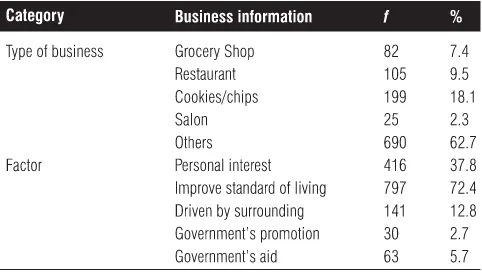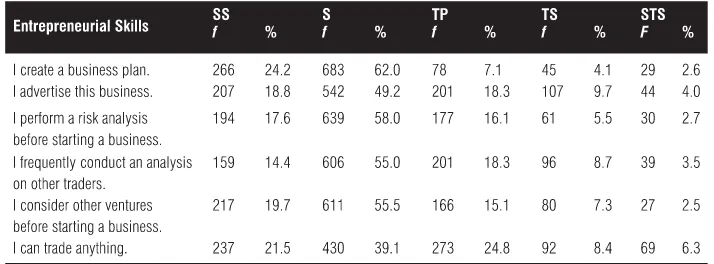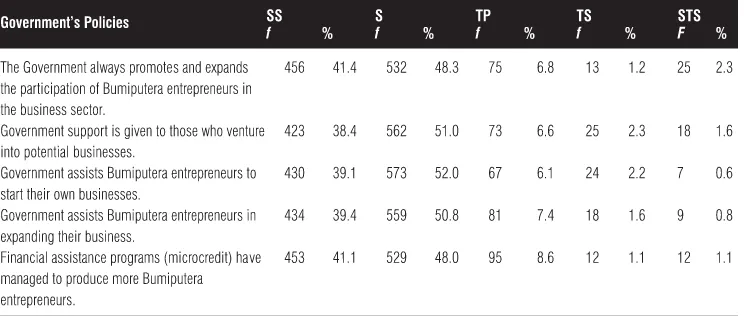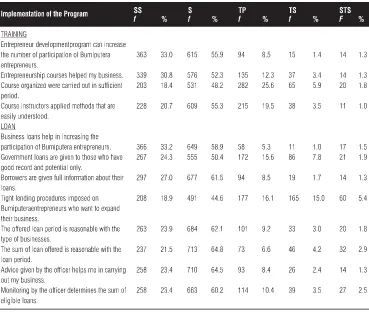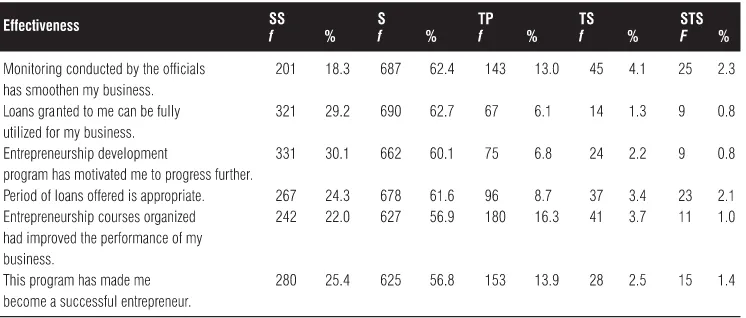of preparing financing opportunities to these entrepreneurs; and (3) among the main issues faced by women-entrepreneurs lie in the repay-ment method, insufficient capital, lack of relevant trainingentrepreneurto increase skills and the lack of mentor system. The outcome of this study is anticipated to be able to improve the policy of entrepreneur develop-ment, especially increasing the number of women inthe field ofentrepreneurship. Apart from that, there are several criticial issues that need to be addressed by the government such as the need to coordinate institutions that offer micro-credit funding scheme, also the need to have a more transparent decision-making process in the distribution of financingallocation.
KEYWORDS: social entrepreneurship model, micro-credit financing scheme, women-entrepreneurs
INTRODUCTION
Social Entrepreneurshipis seen as a proactive effort by the government, private agencies and non-governmental organisations (NGO) to encourage entrepreneurship development among the community that gives various implications in terms of the national economy, social and politics (Wang, 2012). Generally, entrepreneurshipis able to increase national economic growth, contribute to the Gross National Income through job opportunities and at the same time reduce the national poverty rates. In third world countries such as Bangladesh, Nigeria, Kenya, Nepal, Pakistan, Malaysia they have adopted the
Pensyarah Kanan,Pusat Pengajian Kerajaan, Kolej Undang-undang, Kerajaan dan Pengajian Antrabangsa,Universiti Utara Malaysia, 06010 Sintok, Kedah, Faks:049287914, Email: imah@uum.edu.my, T:049287924
Siti Noor Shamilah Misnan
Pensyarah,Pusat Pengajian Kerajaan, Kolej Undang-undang, Kerajaan dan Pengajian Antrabangsa,Universiti Utara Malaysia, 06010 Sintok, Kedah
Entrepreneurs Empowerment
http://dx.doi.org/10.18196/jgp.2015.0007ABSTRACT
socialentrepreneurshipapproach as a measure by the governments to elevate the commuity’s status of living.
According toSyed dan Xavier (2012),
entrepreneurshipgives a great impact to the local economy and eradication of poverty by boosting the emergence of job opportunities, increase wealth and income, and finally help contribute to the greater global economy. Entrepreneursalso have the capability to stimulate the economy through innovations that lead to the economic growth and development.In Kenya, for
example,entrepreneurshiphas produced innova-tion, by giving the opportunities to women to get involved at a higher level in the labour market by drawing in investments from abroad able to create jobs and economic development(Harding dan Harding, 2008).
One of the efforts through thesocial entrepre-neurship is to introduce the microcredit financing scheme programme. Originally, this scheme was founded to bridge the gap of capital financing between rural operations and commercial banks. It is a measure to lay out small-scale loans and accept small-scale deposit savings. According to Otero (1999), the micro-credit scheme gives access to capital, enabling the poor who are self-employed to get productive capital, adress risks and prevent themselves from losing their capital. This scheme is an effort to build assets and create wealth among the poor and the very poor.
In Malaysia, among the poverty development programmes which focus on helping the very poor people are YayasanBasmiKemiskinanand Amanah Ikhtiar Malaysia (AIM). AIMis a very aggressive agency in in providing financial assistance to approximately82% from the total poor and very
poor households in Malaysia. AIM is also the institution that offers the largest and the longest-standing micro-credit financing schemein Malaysia. AIM uses GrameenBank(a micro-financing estab-lishment in Bangladesh) as a model in preparing the credit scheme without security to these two types of households in order to improve their socio-economic status.
Micro-credit financing scheme institutions all over the world including AIM, work towards reducing the rates of poverty by establishing a working model expected to increase the net value of commercial assets owned by very poor house-holds. If we are talking about the largest AIM borrowers, they are women, constituting 90% of the total number of borrowers.
Such a great percentage of women-borrowers is in line with the intention to empower women in theMillennium Development Goal(MDG). MDGhas been constructed by the United Nations to encour-age gender equality and empower women all over the world. This aim has become an indicator to monitor the total number of women involved in non-agricultural sectors (World Bank, 2006). The implications lie in gender equality and women empowerment which become fundamental in making poverty development more formidable. One of the ways to makewomen more productive is through entrepreneurship. Entrepreneurship has the potential to increase the number of women working in non-agricultural sectors. Global Entrepreneurship Monitor(GEM) has shown that the increase in the number of women-entrepreneurs involved in starting new businesses and expand the existing businesses is vital for the long-term eco-nomic growth of a country (Kelly,
BACKGROUND
This study is done based on several measures adopted by the government, the private agencies and NGOs in reducing poverty rates also creating equality in the economic achievement between the people, especially in developing countries. Among the countries that are working on reducing the poverty rates and increasing the life status aggres-sively is Malaysia. One of the strategies adopted is through the field ofentrepreneurship. In
Malaysia,the main issue that is being debated relates to the low rate of involvement ofthe bumiputera inentrepreneurshipand the failure to achieve the New Economic Policy (DEB) target, which places Bumiputera equity ownership of 30%. Based on the current achievement of up toRMK-10, the Bumiputera corporate equity ownership is as follows (TERAJU):
i. Bumiputera ownership at the capital shares was at 21.9% in 2008 as compared to 19.3% in 1990 showing that there is no relative change and the target of 30% stipulated in the NEP is still not fulfilled.
ii. Most Bumiputera corporate equity ownerships are in the field that has a low value towards the National GDNP such as the construction sector 36.4% but the contribution of this sector to the GDNP isonly 3.3%. Conversely, the Bumiputera ownership in the manufacturing sector was only 11.3% compared to its contribution to the GDNP which was 26.6%.
iii. The majority of Bumiputera industries are micro-scale and small scale such as 42% Bumiputeraentrepreneurbusinesses have less than 5 workers, while 21% have 5 to 50 work-ers;
There are several factors that have been
identi-fied by the Malaysian government serving as obstacles to the engagement of Bumiputera entrepreneurssuch as the non-existent funding resources and skills, also the lack of exposure and opportunity to manage the business.(Malaysia, 2002and Norfadzillah, 2010).
Nonetheless, the government sees women-Bumiputera as offering more critical contributions to the national rates of poverty. In Malaysia, the distribution of residents shows that almost half of the residents are women, which is 48.4% from the total number of residentsin the middle of 2013 or 29.9 million (Malaysia Statistics Department, 2014). However, only 15% of women ran their own businesses (Syed, Zizah & Fauzi, 2012). This demon-strates that women’s involvement in the field ofentrepreneurshipis still at low level, although the government has equipped
variousentrepreneurshipprogrammes to give more opportunities to women to get involved in the national economic development and also to reduce the rates of poverty in this country.
Every year, the government has allocated great expenditure to increase women’s status of living. For example in 2010, The Malaysian government has spent RM 4.7 million to assist 946 women through a programme called 1Azam (Muhyiddin, 2010). Meanwhile in 2013, RM50 million was allocated by the government under the
programme I-Kit aiming to help develop women’s business skills (Mohd Najib, 2012).
comprising of low-income households. As the outcome, 60% from the overall participantshad been able to obtain an income totalling RM3500 for 3 months in a row. Also,there are also other agencies involved in offering women entrepreneur-ial development programmes such asMalaysian Small and Medium Industry Corporation (SME Corp. Malaysia), Malaysian Women-Entrepreneur Association Affiliation (FEM),National Association of Women Entrepreneurs, Malaysia (NAWEM). This agency is held responsible in promoting and encouraging Malaysian women’s involvement asentrepreneursother than serving as a platform to build the relationship among them (Teoh & Chong, 2007). However, the percentage of women involved in the field of entrepreneurshipis still low (Syed, Mohd Fauzi & Norasiah, 2011).
Therefore, this study is done to analyse the effect ofAIM’s micro-credit financing schemein creating a strong line of women entrepreneurs. In particular, it seeks to (1) explore the current social entrepreneurship model which uses AIM’s micro-credit financing scheme, (2) to measure the effec-tiveness of AIM’s micro-credit financing schemeto women-entrepreneurs; and (3) to analyse the obstacles and challenges often faced by womenentrepreneurin relation to thecurrent AIM’s micro-credit financing scheme.
THEORITICAL FRAMEWORK THEORITICAL FRAMEWORKTHEORITICAL FRAMEWORK THEORITICAL FRAMEWORKTHEORITICAL FRAMEWORK
THE CONTRIBUTION OF MICRO-FINANCING (AIM) TOWARDS NATIONAL DEVELOPMENT
Although the activities from the micro-financ-ing scheme appear to be scarce, they have left a positive effect towards the development of a country. Through financing offered to the poor, in general, half of the world’s population hs been
able to have financial services’ basic resources. Taking the words of a Nobel Prize winner, Milton Friedman where the poor continues to be poor not because they are too lazy, but the root of the problem is because they do not have the resource to obtain financial loans. Under this pretext, there is a stronger need for the micro financing scheme in the country’s development agenda.
The establishment of the micro financing scheme has given the opportunity to the poor and the low-income people to work on their own in creating their own income and to get them out of the poverty zone; other than that, micro-financing has also increased their chance to get a better income and enhance human resource capability (Manum, 2010).
With the financial capability that they have, members of AIM are able to generate their own income using the start-up capital obtained from AIM’s financing scheme. They are able to improve their living conditions, able to gain access to better healthcare and also able to prepare their children’s school items better. Several studies have been conducted by Sutoro (1990) in Indonesia, Mosley (1996) in Bolivia, Dunn (2005) in Bosnia
striking the most for the poor is that they are able to generate income and also it takes them out from the cocoon of poverty(Hisako dan Hamoni, 2009).
WOMEN ANDENTREPRENEURSHIP
The concept ofentrepreneurshipis an initiative tochange the concept of business as a new effort or an industry that has the potential to succeed. Entrepreneurshave to be sensitive to changes and are always seizing the opportunities, using the skills and also are bold enough to take risks when opening up market.
Women entrepreneurship has been acknowl-edged as an important indicator in economic growth. Women entrepreneurs are able to create job opportunities for themselves and for others. Entrepreneurshipamong women is the position of women in the society and their role as entrepre-neurs in the society.All over the world, this shows that women still represent the minority group of the society that starts their own businesses or are self-employed. The low participation of women is caused by certain obstacles that they need to overcome in order to get the same opportunities as the male counterparts. Among the main obstacles faced by women in the field of entreprenurship are the types of education, the lack of
role-modelinentrepreneurship, family responsibilities, poor social status, and the lack of access to finance (OECD, 2004).
In particular, with the improved industrializa-tion, responsibilities on family and children have been of utmost importance. Women still lead the way in family and children upbringing. With the growth of industrialization and development, child custody and productive work have become
increas-ingly important issues for women in the labour market. In advanced countries, workplace is usually far from home and the work schedule is not really flexible to allow working women to manage their children. Thus, women (as it is common for women to take care of the children) who wish to workneed to find an alternativefor their children’s custody and care (Brewster & Rindfuss, 2000). With children being under proper care, women are more ready to take any part in the labour market, includingentrepreneurship. Childcare enables women to manage their career and func-tion as a mother. The field ofentrepreneurshiphas opened doors for women to adopt both roles.
many factors which influence women to make decisions to start their businesses,as there are several main obstacles that lead to the few women categories entering business and succeeding.
This imbalance has an implication for economic growth and national development. Lately, a lot of women generally become entrepreneurs to estab-lish their own businesses. The role
ofentrepreneursis acknowledged at the local level, district and international levels according to their satge of entrepreneurial development. Entrepre-neurs also contribute to the economic growth and development through job opportunities, income generation and wealth ownership. Wealth owner-ship reduces the number of people who live with income below the poverty line.
Past studies show that women’s involvement in economic activities can empower women in women’s lives and themselves. Sen (1987) looks into two approaches where the activities that generate women’s income can enhance their lives and their families. First of all, the increased in-come of the householdand the second is the increase in women’s contribution towards the household income. Income can give women a clearer picture about their personality, wellbeing and higher contributionsto their families’ eco-nomic status. Empowering women has a critical impact towards the national economic profit (Ditanam & Sebstad, 1989). Women’s economic activity that contributes to household income relates to freedom, power and status of women as enjoyed by men as it influences the perceptions of who contributes to the family. Free lifestyle and outdoor income also have some social conse-quences, crucial in terms if the income and support (Sen, 1987; Osmani, 1998). Thus, it is clear that
access to micro-credit scheme financing does not only create wealth and enhance women’s level of economy but it also makes them more empowered.
WOMEN ENTREPRENEURSHIPIN MALAYSIA
In Malaysia, the government really takes seri-ously women development programmes, where one of the programmes developed is the women entrepreneur development programme. This programme seeks to ensure that women-entrepre-neurs are not left behind in terms of the national development and nasional development agenda. AIM is identified as one of the tools used for the purpose of increasing the capabilities of women entrepreneurs in Malaysia.
According to Hamdino, Pazim and Wan Sabri (2012) poverty eradication program using the method ofentrepreneurshiphas long been practised in Malaysia, starting with the introduction ofNew Economic Policy.Entrepreneurshiphas been prac-tised to increase the capability of the National economy. The implementation continues until today with the introduction ofK- Economy.
The micro-financing scheme practised in Malay-sia has opened up more opportunity to women to get involved in the field ofentrepreneurship. AIM has provided training for women to own entrepre-neurship skills. Among the training provided by AIM to its participants are entrepreneurial charac-ter building, entrepreneurship basic training, basic skill training and business skill
women engaged inentrepreneurshipbecome more confident in managing finance and making deci-sions in their business activity.
RESEARCH METHODS
This study uses the quantitative approach through the survey distribution. It is distributed to participants using the Likert Scale.
The respondents chosen for this study are participants or borrowers from AIM agencies. 1101 participants were involved as our study sample involving four zones namely the North, South East and West. Specifically, respondents involved are from Pahang, Sabah, Kedah, Perak, Johor, Kuala Lumpur, Kelantan and Terengganu.
The study instrument involves one (1) set of survey form to analyse 9 main components related toentrepreneurship. Questionnaires were formu-lated based on items’ adaptation in theentre-preneurshipmodel by Ligthelm (2010). The ques-tionnaire was divided intonine (9) sections.Section A was designed to collect information on the respondents’ demography and Section B covers respondents’ business information. Next, Sections C, D, E, F, G, H and I were formulated to measure the micro-credit scheme itself.
The survey form was divided into 9 sections containing 65items encompassing 9 main sections, namely Demography (12 items)Business Informa-tion (6 items), Entrepreneurship Skills (6 items), Business Competition (6 items), Small Business Advantage l(4 items), Government Policy(5 items), Implementation (12 items), Effectiveness (6 items) and Business Survival (8 items).
RESULT AND ANALYSIS
BUSINESS INFORMATION
TABLE 1: BUSINESS INFORMATION
Table 1 above shows the distribution of fre-quency and percentage for business information category and factors that cause people to start a business. Types of business ventured by entrepre-neurs includegrocery shops, restaurants, cookies or chips, salon and others. Based on Table 1, the majority of respondents had other types of busi-nesses consisting of 690 persons or 62.7%. The second highest number belongs to cookies or chips business with 199 persons or 18.1%. This was followed by restaurant business with 105 persons (9.5%), grocery shops with 82 persons (7.4%) and salon with number of respondents of 25 (2.3%).
persons (2.7%) chose the government’s promo-tions.
ENTREPRENEURIAL SKILLS
Table 2 clearly shows that the level of agree-ment is higher than the level of disagreeagree-ment and level of uncertainty towards entrepreneurial skills. Four (4) of the six (6) items in the table indicate a high level of agreement that exceeds 50% towards entrepreneurial skills. The majority of respondents agreed with the item of creating a business plan, namely 683 person or 62.0%. Besides that, most respondents also agreed to the item of conducting a risk analysis before starting a business which corresponds to 639 persons (58.0%), consider other ventures before starting a business corresponding to 611 or (55.5%) and analysing other traders
corresponding to 606 persons (55.0 %). The item “I can trade anything’ has the lowest level of agreement which corresponds to 430 persons or (39.1%) yet showed high levels of uncertainty, with 273 persons, with the percentage of 24.8%.
BUSINESS COMPETITION
Table 3 above clearly shows that the respon-dents’ level of agreement towards business competi-tion is higher than the level of disagreement and level of uncertainty. Based on the findings shown in Table 3, all items showed a high level of agree-ment that exceeds 50% towards the eleagree-ments of business competition. The majority of respondents agreed that the offered businesses choose a com-fortable environment which corresponds to 636 persons or (57.8%). Besides that, a total of 618
TABLE 2: ENTREPRENEURIAL SKILLS
person or 56.1% agreed that their businesses offer better customer service and 613 persons or 55.7% agreed that their businesses offer products of better quality. Table 3 shows the item ‘business is selling the same product with other businesses’ recorded the highest number of persons that disagreed namely 177 persons (16.1%). Meanwhile, the item ‘the location of my business is more strategic’ recorded the highest number of uncertainty which corresponds to 199 persons or (18.1%).
THE ADVANTAGE OF SMALL INDUSTRIES
Based on Table 4, the research findings also clearly show that the level of agreement is higher than the level of uncertainty and level of disagree-ment among respondents towards the advantage of small industries. The results showed that all four
(4) items have a high level of agreement that exceeds 50% in the element of the advantage of small industries. The item ‘theprice of my business products is negotiable to attract customers’ and items ‘I can diversify my products’ has the highest number of 630 persons or 57.2% respectively. Meanwhile, the item ‘my business environment is more safe and secure’ recorded 625 persons or (56.8%) who agreed and the item ‘my business hours are longer and flexible in order to attract customers’ recorded agreement from 603 persons or (54.8%). Despite having a high level of agree-ment, the item ‘my business hours are longer and flexible in order to attract customers’ also recorded the highest level of uncertainty with 164 persons or (14.9%).
TABLE 4: THE ADVANTAGE OF SMALL INDUSTRIES
GOVERNMENT’S POLICIES
Table 5 clearly shows that the level of agree-ment is higher compared to the level of disagree-ment and level of uncertainty towards
government’s policies. Three (3) out of five (5) items in Table 5 show high level of agreement that exceeds 50% towards government’s policy. The majority of respondents agreed with the item ‘government assists Bumiputera entrepreneurs to start their own business with 573 persons or 52.0%. In addition, many respondents also agreed with the item ‘government support is given to those who venture into potential businesses’ with 562 persons or (51.0%) and the item ‘government assists Bumiputera entrepreneurs in expanding their business’ with 559 persons or (50.8%). The item ‘financial assistance programs (microcredit)
has managed to produce more Bumiputera entre-preneurs’ has the lowest level of agreement of 529 persons or (48.0%) but showed high levels of uncertainty, namely a total of 95 persons with a percentage of 8.6%.
IMPLEMENTATION OF THE PROGRAM
Based on Table 6, the research findings show that there are two (2) types of program implemen-tation that have been carried out in terms of training and loans. Table 6 above clearly shows that the level of agreement of respondents towards training is higher than the level of disagreement and level of uncertainty. Based on the findings, three (3) out of the four (4) items exhibit a high level of agreement that exceeds 50% of the train-ing element. Most of the respondents agreed that
entrepreneur development programs can increase the number of Bumiputera entrepreneur participa-tion which corresponds to 615 persons or 55.9%. In addition, a total of 609 persons or 55.3% of the course agreed to use methods that are easily under-stood and 576 people representing 52.3% agreed that entrepreneurship courses have helped their business. The item ‘course organized were carried out in sufficient period’ has the lowest level of agreement totalling 531 persons or (48.2%), but it showed a high level of uncertainty namely with 282 persons or 25.6%.
Table 6 clearly shows that the level of agree-ment is higher than the level of disagreeagree-ment and level of uncertainty towards the loan element. Seven (7) out of eight (8) items in the table indicate high level of agreement that exceed 50% regarding
loan aspect. Majority of the respondents agreed with the item ‘the sum of loan offered is reason-able with the loan period’ with 713 persons or 64.8%. Besides that, most of the respondents also agreed with the item ‘advice given by the officer helps me in carrying my business’ with 710 persons or (64.5%) and the item ‘the offered loan period is reasonable with the type of businesses with 684 persons or (62.1%). The item ‘tight lending proce-dures are imposed on Bumiputera entrepreneurs who want to expand their business’ recorded the level of agreement that is less than 50% which corresponds to 491 persons or (44.6%) but showed a high level of uncertainty with 177 persons with a percentage of 16.1%.
TABLE 7: EFFECTIVENESS
EFFECTIVENESS
Table 7 clearly shows that respondents’ level of agreementtowards effectiveness is higher than the level of disagreement and level of uncertainty. Based on research findings as shown in Table 7, all items showed high level of agreement that exceed 50% towards the elements of effectiveness. The majority of the respondents agreed that monitor-ing conducted by the officials have smoothen their business which corresponds to 687 persons or (62.4%). In addition, a total of 690 persons or 62.7% agreed thatthe loans granted to them can be fully utilized for their business and 678 persons or 61.6% agreed with the item ‘period of loans offered is appropriate’. Meanwhile, the highest number of uncertainty level recorded by the item ‘entrepreneurship courses organized had improved the performance of my business’with 180 persons or who represent 16.3%.
THE FUTURE OF BUSINESS
Based on Table 8, one (1) item has a disagree-ment level higher than the level of agreedisagree-ment and level of uncertainty whereas another two (2) items showhigher level of agreement compared to level of disagreement and level of uncertainty towards the future of business among respondents. Based on Table 8, the research findings show that the level of disagreement is highest on the item ‘my business cannot continue and will be closed’ which corresponds to 431 persons or 39.1%. In contrast, a total of 597 persons or (54.2%) agreed that their business can continue but they need financial assistance with 615 persons (55.9%) agreeing that their business would be viable and has the poten-tial to succeed.
CONCLUSION
Findings obtained from this study show that most women entrepreneurs agree that micro-credit schemes have been successful in improving their lives through entrepreneurship which they have ventured. However, they suggest that
businessknowledge such as business planning and risk analysis is also included in the compulsory courses organized by AIM. This is because, most women entrepreneurs are aware about the exist-ence of fierce competition in the business hexist-ence they should always learn more aboutthe business, so that they are able to be competitive in the long term.
Entrepreneurship through microcredit schemes possess several advantages to small-scale businesses in a way that it can diversify product and the price offered is negotiable to attract customers. In
addition, it is observed that government’s aid could help entrepreneurs to start or expand their busi-nesses. The implementation of micro-credit
schemes may also increase the number of entrepre-neurs and help women entrepreentrepre-neurs via advice and ongoing monitoring from corresponding parties. Next, the micro-credit financing scheme would determine the business viability among womanBumiputera entrepreneurs. The majority of women entrepreneurs have the potential to suc-ceed and continue their business with financial assistance given upon them.
members, as well as required to make payments for their own loan.
Generally, micro-credit financing scheme is seen to be helping women entrepreneurs to sustain their businesses, but it can be further improved through several approaches. Firstly, most of the loaned capital and training given to entrepreneurs have not been systematically evaluated to measure the effectiveness of the programs offered. A study conducted by the Global Entrepreneurship Moni-tor (GEM) on business environment in Malaysia found that aspects of monitoring and evaluation from government are weak in terms of
policiesmade which have prevented the formation of new businesses, government regulation and bureaucracy, such as business license requirements which preclude the existence of a new business to grow. This situation has raised doubts among the public on the seriousness and effectiveness of government in supporting and encouraging the growth of businesses. (Teoh & Cheong, 2007).
Secondly, although as a whole, there are various entrepreneurship programs in the form of both financial and non-financial, programs which focus on women’s entrepreneurship are still limited. Therefore, more initiatives should be undertaken to empower women by introducing alternative entrepreneurship programs in accordance with the needs and background of women entrepreneurs.
REFERENCES
Abdullah, Sazali & Mohamad (2014). Empirical investigation on the impact of microcredit on women empowerment in urban Peninsular Malaysia. The Journal Developing Area. 48 (2) 287-306
Abdullah Al-Mamun, Adaikalam, J., Mohamad
Nurul Huda Mazumder & Sazali Abdul Wabah (2011). Comparing the effect of Amanah Iktiar Malaysia’s (AIM) microcredit program on quality of life in urban and rural Malaysia. African Journal of Business Management Vol. 5 (34), 12981-12995
Harding, R & Harding, D. (2008). Kenya in the wake of the election: An entrepreneurial wake-up call, Report to the Sacoma-World
Enterpreneurship Summit, East Africa, May 26th-27th, 2008.
Kelly, D., Bosma, N. & Amoros, J.E. (2010), Global Entrepreneurship Monitor Report, 2010 Global Report.
Mohd Najib, (2012), Ucapan YAB Dato’ Sri Mohd Najib B. Tun Abdul Razak, Perdana Menteri Malaysia Sempena Sambutan Hari Wanita Kebangsaan di Sunway Convention Centre pada 2 Oktober 2012.
Mohamed Zaini, Che Supiah & Norzaini (2012). The economic performance of Amanah Ikhtiar Malaysia rural microcredit programme: A case study of Kedah. World Journal of Sosial Science. 2 (5), 286-302.
Muhyiddin Yassin, (2010), Ucapan Sempena Majlis Simposium Usahawan Wanita 2010 di Pusat Konvensyen Lembaga Pembangunan Industri Pembinaan Malaysia (CIDB).
Nor Fazidah (2011). The role of microfinance in poverty allaviation: AIM’s experience. Report prepare for 2nd working group on the development of
Islamic financial service industry in Jakarta. Syed Shah Alam, Mohd Fauzi Mohd Jani and Nor
166-175.
Syed Shah Alam, Zizah Che Senik and Fauzi Mohd Jani, (2012), An Exploratory Study of Women Entrepreneurs in Malaysia: Motivation and Problems, Journal of Management Research, Vol.4, No.4, pp.282-297.
Syed Zamberi Ahmad and Xavier, S. R., (2012), Enterpreneurial Environments and Growth: Evidence from Malaysia GEM Data, Journal of Chinese Enterpreneurship, Vol.4, No.1, pp.50-69.
Wang, J., (2012), HRD for Societal Development: What We Can Learn from Social Entrepreneur-ship in the Developing World? Advances in Developing Human Resources, DOI: 10.1177/ 1523422312446145.
World Bank (2006). World Development Indica-tors, Washington DC: World Bank.
